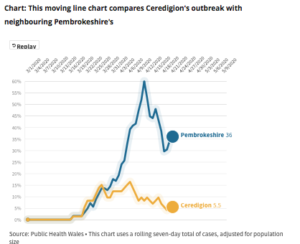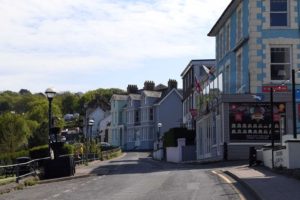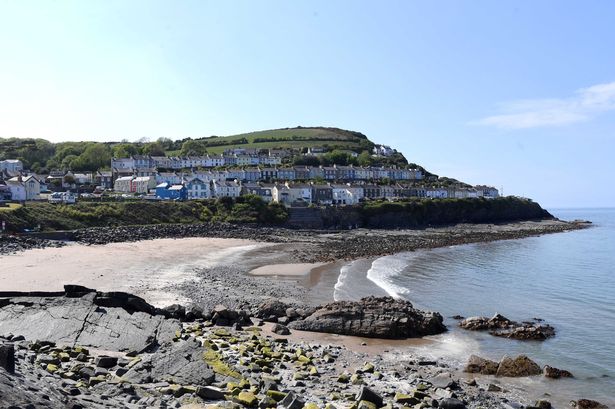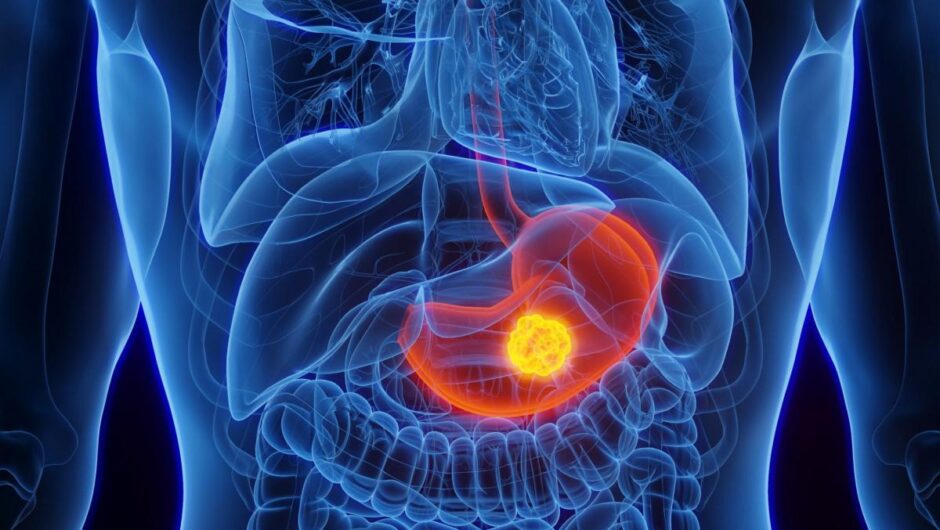[ad_1]
As Wales takes the first steps out of lockdown and starts trying to find a way to live with Covid-19, people living in one part of the nation could be forgiven for thinking they have almost entirely escaped the disease which reached crisis points in other parts of Wales.
With just 42 confirmed cases to date, and 7 deaths, it seems that, in the coastal council area of Ceredigion, the virus never really took hold.
The initial flurry of cases in this rural part of Wales was comparable to the starts of the outbreak in the local authorities of Wales that ended up being worst hit by the virus. Yet here, it just sort of petered out.

Chart: This moving line chart compares the outbreaks in Cardiff, Newport and RCT with the lack of cases in Ceredigion
On the face of it, the geography of the largely rural county could explain the relatively low spread of cases, with no large population centre like in Newport or Cardiff.
Mirroring the swift acceleration of cases already seen in countries like Italy and Spain, heavily urbanised Newport reached its peak on April 2, with Cardiff and RCT not far behind.
Across the world, big cities were the first hit by Covid-19 and the hardest hit. Population density has, unsurprisingly, been cited as one of the biggest catalysts for the virus to spread.
Yet this alone does not explain why Ceredigion was spared. Neighbouring rural areas of Wales were far worse affected. The latest data from Public Health Wales show Powys has had 216 cases for every 100,000 people in the area. Pembrokeshire 279. Gwynedd a painful 449.
In comparison, Ceredigion has had just 57. Nor can this be accounted for by a lack of testing. The pitiless eye of the ONS shows that Ceredigion has had the fewest deaths where Covid-19 is mentioned on the death certificate: 9.6 for every 100,000 people compared to 30 in Pembrokeshire, 53 in Gwynedd and 64 in Powys.
Neither can it be that the deaths simply weren’t attributed to Covid-19. Data from the ONS shows that there have been hardly any excess deaths in the Hywel Dda health board area. The spike in the south and south-east of Wales simply doesn’t show up here. And Ceredigion has been the area of Hywel Dda with the least Covid-19.
It might be tempting to think that the virus never got here. Yet this isn’t true either. Look at this line chart below which shows Ceredigion’s outbreak tracking identically to that of neighbouring Pembrokeshire’s for the first two weeks until it, somehow, just subsided.
This isn’t just a story worthy of Welsh attention but across the UK. In the mainland, no local authority has had fewer cases. Even the Highland council of Scotland has has had more (82 for every 100k people).
So what happened?
Chart: This moving line chart compares Ceredigion’s outbreak with neighbouring Pembrokeshire’s
One big difference that sets Ceredigion apart was that even before it had recorded its first case of Covid-19, it had set up a “homemade” in-house test track and trace system.
The man behind it, Barry Rees, the corporate director for Ceredigion Council, is a scientist by training. He believes contact tracing is the only way of “pursuing the disease then rather than following it”.
Is this the reason for why the county has emerged unscathed? Has a simple contact tracing system saved hundreds of lives, and what does it mean for the population in life after lockdown who haven’t yet built up immunity?
Gold command
In the early days of the coronavirus pandemic, before the first death had been recorded in Wales, Ceredigion Council convened their first Gold Command meeting.
Bringing together the key people in the council, including leader Ellen ap Gwynn and Mr Rees, they needed to decide what to do.
Just weeks before Easter, the Ceredigion population would have been twice its normal size due to the thousands of students at Aberystwyth University and the early-season holidaymakers flocking to resorts like Llangrannog and New Quay along the Cardigan Bay coastline.

New Quay during lockdown
(Image: WalesOnline/ Gayle Marsh)
They had already worked closely with the university, which was one of the first universities to close in Wales. And, long before the national lockdown was announced, the council had instructed all holiday and caravan parks to close too.
Thanks to the council’s “proactive” action, by mid-March, they were down to their “core population”, said Mr Rees. But even so, Eifion Evans, the chief executive at CCC, challenged the group in Gold Command: “Are we missing a trick? Is there anything we haven’t done?”
Sat around that table, Mr Rees, who was a biology teacher for 16 years, cast his mind to what happens with other notifiable diseases like legionella and food poisoning. In those cases, it was up to the council’s public protection team to set up a contact tracing system and carry out investigative work, so why not do the same for Covid-19, he thought.
“So I piped up about having read about contact tracing in south east Asia where they had trialled it and were able to put the manpower in to do it,” said Mr Rees, who has been in his current post for two years.
“I knew we had the skillset and so I got a couple of colleagues together who created something, based on research which was happening internationally.
“At first, it was nothing complex – just a simple questionnaire which could be filled in manually, as a way of contact tracing. That’s the way it has developed really, probably helped by our lower numbers.”
Council area Total cases Cases per 100k people
Ceredigion 42 57.5 Powys 287 216.7 Pembrokeshire 279 223.1 Flintshire 466 299.5 Isle of Anglesey 234 334.5 Gwynedd 445 358.4 Bridgend 527 363.8 Monmouthshire 348 369.7 Torfaen 346 371.8 Caerphilly 701 387.3 Carmarthenshire 735 391.9 Neath Port Talbot 609 426.2 Wrexham 581 426.8 Conwy 558 476.2 Blaenau Gwent 335 480.5 Vale of Glamorgan 664 502.4 Swansea 1270 515.3 Newport 842 549.2 Cardiff 2108 578.7 Merthyr Tydfil 403 669.6 Denbighshire 647 678.7 Rhondda Cynon Taf 1662 692.1
Mr Rees says that simple system has enabled them to carry out contact tracing on every confirmed case in the county. He said: “We’ve done so for the past seven to eight weeks now. We’ve picked up all positive cases and been contact tracing on them all.”
A couple of environmental health officers were assigned to pick up on positive tests. Precautions were even extended to their own staff.
“We’ve got a HR system where people will put down a reason for their absence on a daily basis,” explained Mr Rees. “So we check to see if anybody has put down their absence for coronavirus symptoms. We picked those up and were able to contact them as well.”
Before they could begin, the team, led by Mr Rees, had to set out the “moral imperative”.
“We also had a colleague from data protection,” he continued. “Because for the first time really we were using peoples’ data to contact potentially a secondary contact who was or wasn’t a member of their close family. So we were using their data in a new way, so we checked that out with our data protection officer and he liaised with the information commissioner office.
“We set up our own very simple data management system. It was a manual effort with one of the environmental health officers picking up the phone, explaining what we were trying to do. In the beginning, people weren’t aware of a test, track and trace system so we had to explain all of that to them.
“The data we collected was input to our data management system, which was very much homemade, so no one was scribbling down responses on a piece of paper. Then we used our in-house environmental health expertise to help decide how and when to contact people.”
A race against time
Mr Rees, 51, is keen to stress he is “just the ideas person” who “facilitates the work”. He adds: “The doing has been done by other people.”
He believes effective contact tracing is a race against time which is why his system took a conservative approach and assumed every symptomatic person was assumed to be a positive case.
“Numbers started off pretty low and there was one busy weekend where we had a couple of positive tests we needed to follow up,” explained Mr Rees. “We also had some symptomatic members of staff and we really needed to snuff that out and pursue that.
“They’ve subsequently been tested and that test was negative but we did some preventative stuff, prior to the test. One of the worries is that, if the starting point for the contact tracing is a positive test, you’re already some way down the line. If people aren’t following the advice being given, then you’re missing a few days for people to go through the further process of being tested. You might be losing 48 hours where these people may not be following the guidance and potentially spreading the virus.
“We short circuited that loop and did’t wait for their test results to come back before taking action. We were able to send a note down to our contact tracing team to gather more information. If they’re showing symptoms then there’s almost the presumption of a positive test and that guides the advice we give to them.”
As the rest of Wales starts to catch up with Ceredigion, with a national test, track and trace system being rolled out right across the country, Mr Rees says we have to be “careful what we wish for”.
A decision needs to be made, he says, between either speeding up the turnaround time for getting test results – “that’s got to be really really quick”, or instigating contact tracing with a starting point of when people exhibit symptoms.
“You’ve got to be careful what you wish for because suddenly we could swamp the whole system and the system could fail because of the numbers involved,” he warned.
“In an ideal world we’d have the capacity to catch people when they’re symptomatic, do some contact tracing and advise them on their behaviours and that would be able to really get hold of it. We’d be really pursuing the disease then rather than following it then.”
This map shows where the highest density of Covid-19 deaths have been in Wales
Council area Total deaths Deaths per 100k people:
Ceredigion 7 9.6 Isle of Anglesey 21 30.01 Pembrokeshire 38 30.38 Wrexham 50 36.73 Carmarthenshire 73 38.92 Gwynedd 53 42.68 Conwy 58 49.49 Bridgend 86 59.36 Vale of Glamorgan 83 62.8 Powys 85 64.18 Neath Port Talbot 92 64.38 Flintshire 102 65.55 Monmouthshire 63 66.92 Caerphilly 125 69.05 Torfaen 63 71.33 Denbighshire 68 71.33 Swansea 190 77.09 Blaenau Gwent 60 86.07 Cardiff 341 93.62 Newport 152 99.15 Merthyr Tydfil 61 101.36 Rhondda Cynon Taf 251 104.5
Mr Rees is wary about putting Ceredigion “on a pedestal” for “doing anything better than anybody else”.
“We’re pretty pleased with the low numbers but I certainly wouldn’t want anything to suggest we’re complacent about it or that were doing anything better than anybody else,” he said.
“We’re as vulnerable to this as anybody else really, but we have really tried to be proactive and thinking actively about this from the very beginning.
“On the one hand you would think we would be among the most vulnerable now because we have very little immunity in the population.”
He said just as important has been the “good level of compliance” by those living in Ceredigion. And the geography of the rural authority has helped immensely.
“If you measure the distance from the A55 to the M4, we’re probably the furthest away from both of those,” he points out. “It’s a combination of factors really.
“It’s difficult to get cause and effect and to look at all the different factors and metrics that have helped.”
Virology expert Dr Rich Stanton, of Cardiff University, said there was also a possibility that the virus started spreading slightly later in Ceredigion, just through chance.
He explained: “This means that they had fewer cases when lockdown was brought in, and so the total number of cases remains low now. The geography of the area may play a role too. The virus is likely to spread more slowly in more rural areas, simply because people don’t interact as closely and as often compared to the middle of a busy city – so someone who in infected can’t transmit the virus to as many other people.”
Commenting on the spread of coronavirus westwards through Wales, Dr Phil Kloer, medical director and deputy chief executive at Hywel Dda University Health Board said: “Evidence has shown that to date the number of positive Coronavirus cases has declined as you move westward, through Cardiff, Cwm Taf, Swansea and then the Hywel Dda area, with the lowest rate in Wales being in Ceredigion. This demonstrates a pattern based on previous experiences of new infections arriving in Wales, with infections tending to arrive through travel pattern along motorways and trunk roads from more urban areas.
“We believe the rurality and population density of Hywel Dda counties (Carmarthenshire, Ceredigion and Pembrokeshire) is a significant factor in accounting for the variation in spread of infectious disease, which is further reflected by the population of Ceredigion being the smallest of our three counties.
“We continue to follow the latest Government and Public Health Wales advice and guidance as we gradually move out of some lockdown restrictions, and because of the natural rural distancing in this locality, it is likely that we will continue to see further sporadic cases for some time in west Wales.
An example to others
The home-grown Ceredigion system impressed the Hywel Dda health board and Ros Jervis, director of public health, decided to roll it out to the neighbouring counties of Pembrokeshire and Carmarthenshire.
It’s still early days, having been in place for less than two weeks, with both counties testing it out in their care homes.
“The job now really is to make sure what we’re doing is fully compatible and we don’t develop ourselves into a cul-de-sac,” added Mr Rees. “We’ve got to turn around and do something different because of the national model. So we’re not investing time and resources into further developing our system.
“We’ve got a holding position where we keep doing the contact tracing at the moment and are also part of a pilot within the national system and we’re looking at little ways where we can share some learning.”
The Wales-wide contact tracing system will roll out a national data management system, which is supposed to be up and running by June 8. Welsh Government has set targets to scale up the contact tracing and the council is now recruiting additional contact tracers to help meet this and scale up “as required”.
The challenge now for Ceredigion is how it scales up its capacity for contact tracing.
“In Ceredigion, it’s been quite small scale, explained Mr Rees. “We’ve made about 30 contacts all told because of our low number of cases. We haven’t missed anybody out.”
[ad_2]
Source link



